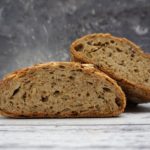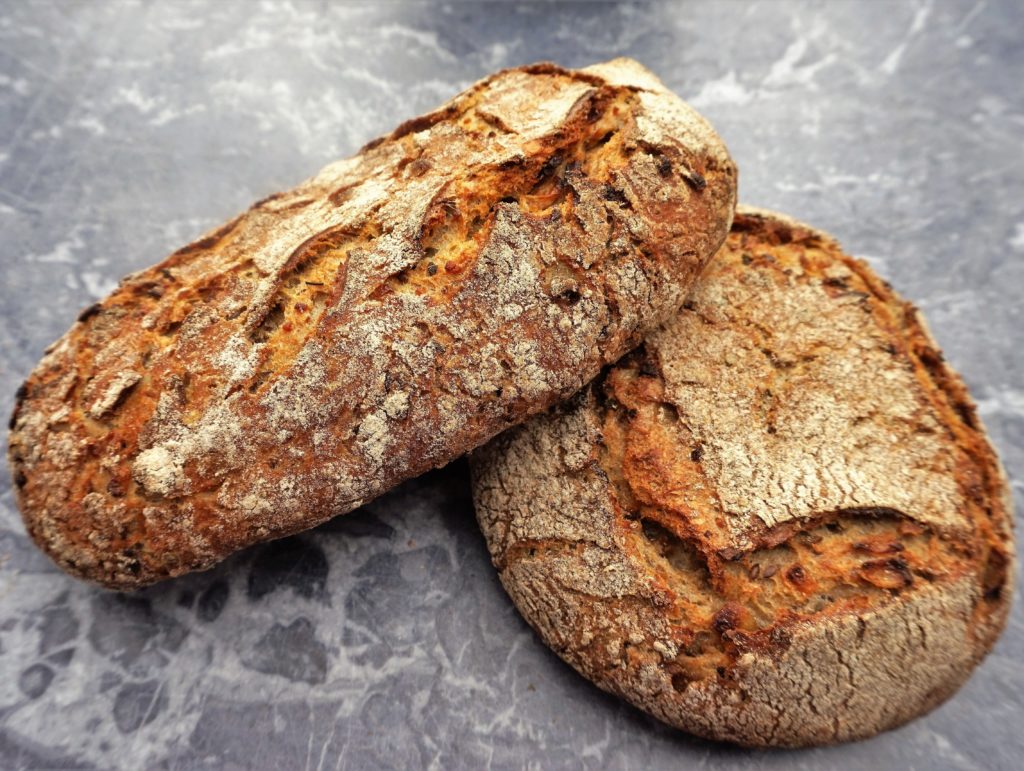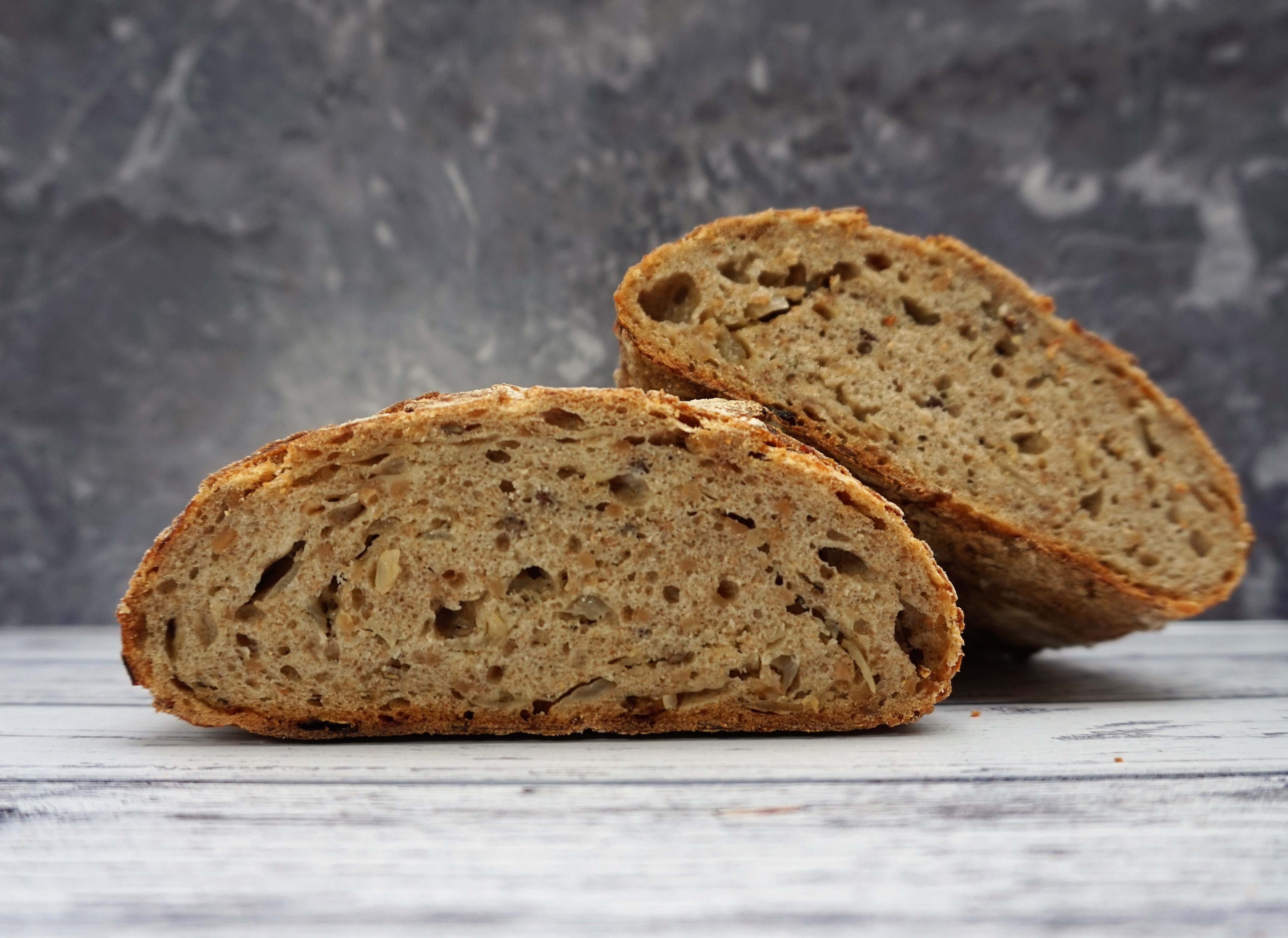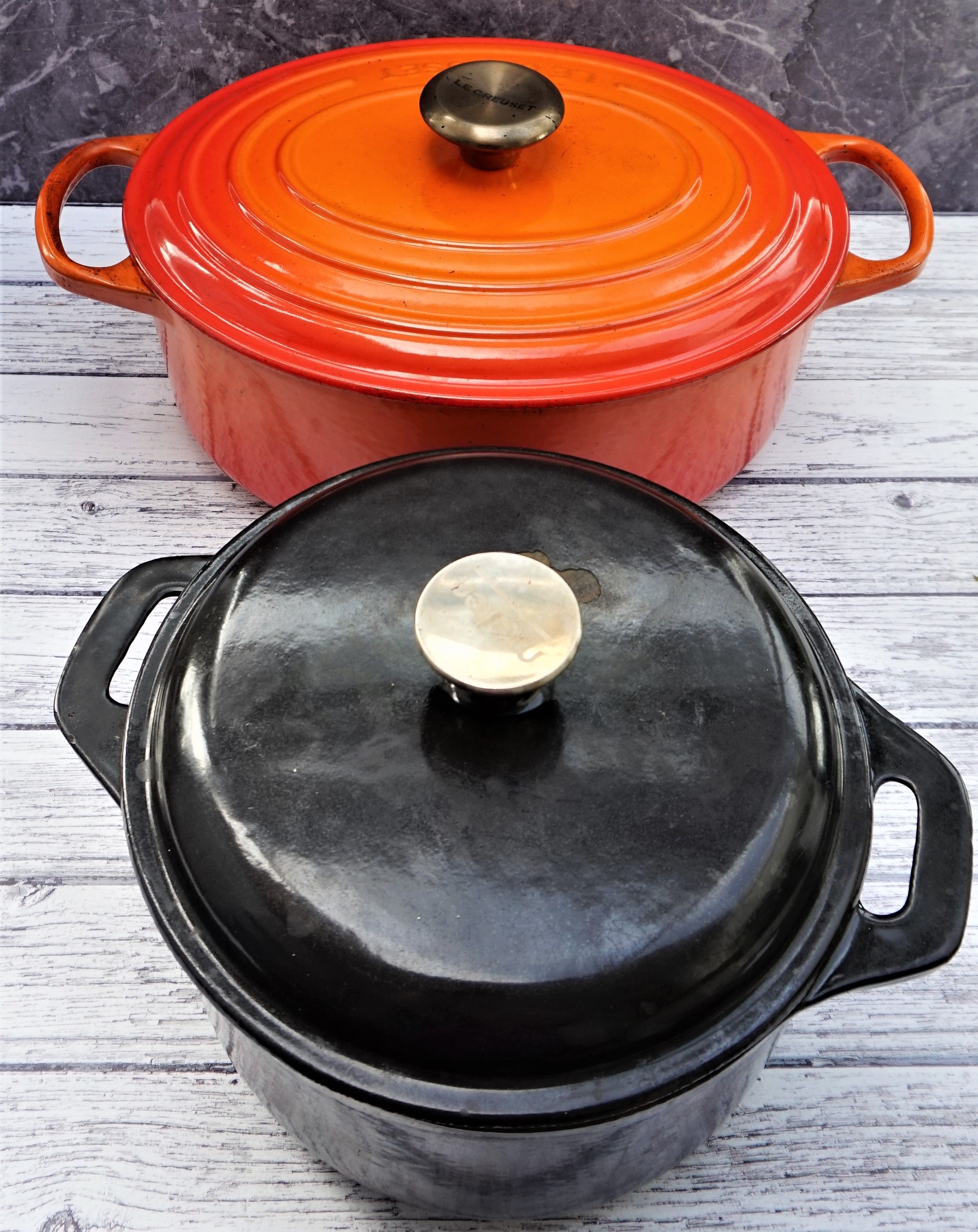Roasted Onion Sourdough with Flaxseeds & Toasted Bulgur
Roasted Onion Sourdough has the wonderful combination of fresh baked bread with roasted onion and a subtle hint of sage.
Nutty bits of flaxseed and bulgur wheat give texture, while a blend of rye, malted and white flours give good flavour without the loaf being too heavy.
Jump to Recipe
For this year’s Sourdough September, an initiative of the Real Bread Campaign to promote the making of proper sourdough, I set myself the challenge of creating some new, flavoured versions of my basic sourdough bread recipe
First off was my Sourdough Beer Bread which turned out pretty well.
My next experiment, which I’m tempted to say might even be my best bread ever, is this Roasted Onion Sourdough with Flaxseeds & Toasted Bulgur.
MY SOURDOUGH
Some time ago, when I was baking mainly yeasted rather than sourdough bread, I occasionally made a roast potato and onion loaf.
While I loved the flavour, I found it a little too heavy. So I changed it to just onion bread, but with some toasted bulgur wheat for texture. I really liked that bread, great with soups and salads or in sandwiches, so recently decided that I’d recreate it as a sourdough loaf.
For all my sourdoughs, you need to be a little bit organised and start the bread making process the night before you want to bake it.
Actually, if the starter you’re going to use has been stored in the fridge a while, you’ll need to plan a few days ahead as the starter will want feeding and bringing back to bubbly life again.
While the recipe card at the end of this post contains full instructions for making Roasted Onion Sourdough, if you want to understand the reasoning behind my method then have a read through my No-knead Sourdough post first.
Briefly, the dough is made the night before you want to bake. In the morning, the bread is shaped and left to finish proving.
When it’s ready, the bread is baked in a lidded pot for the first 30 minutes. The steam created, coupled with the very high temperature, gives a fabulously textured bread with a crunchy, beautiful crust.
ROASTED ONION SOURDOUGH
I’ve found that for this recipe, a combination of different flours works well. I use about half white bread flour, a quarter rye and a quarter malted grain brown bread flour (Dove’s Farm Malthouse Bread Flour to be exact).
But you can use pretty much any combination. Just bear in mind that, having less gluten, more rye flour will result in a denser bread. I use rye flour more and more often now though, as I love the additional flavour it brings.
I prepare the bulgur, flaxseeds and onions for this bread the night before. That way, I have everything ready when I want to get baking in the morning. But if it suits you, there’s no reason you can’t prep them on the day. Just allow enough time, including cooling, before incorporating into the dough.
ONIONS
Roasted onions give a delicious flavour to the bread, almost both sweet and savoury. And the aroma of onion bread baking must be one of the most appetising smells you’ll ever get in your kitchen.
Just make sure you’re not stingy and put plenty in. I like to add a little sage along with the salt, pepper and olive oil to roast the onions, but thyme would be good too.
After roasting, the onions can sit in the fridge overnight.
BULGUR WHEAT & FLAXSEEDS
I’ve loved bulgur wheat since I first discovered it about 30 years ago, and I still prefer its nuttier, firmer texture to couscous.
In those days, away from the cities, you could only buy such things at ‘wholefood’ or ‘healthfood’ shops. At that time I was vegetarian, then vegan, so found myself having to do as much of my shopping as I could afford at such shops. Thankfully, you’ll now find bulgur, and flaxseeds, at almost every supermarket too.
In this bread, besides increasing the nutritional value, they also add pleasing texture.
I simply soak the bulgur and flaxseeds together in boiling water, then set aside until morning.
ON THE DAY OF BAKING
The next day, the bulgur wheat, flaxseeds and onions are incorporated into the dough.
I first flatten out the dough on a floured work surface. Make sure you’ve plenty of extra flour to hand as it can get quite sticky!
I find it easiest to start with half the bulgur, seeds, and onions first of all, so just throw them over the surface of the flattened dough.
Then bring over the sides, right and left, to cover the filling. I use a dough scraper for jobs like this – great for scraping dough off work surfaces or out of bowls. Flatten the dough again then top with the remaining bulgur, seeds and onions. Fold the sides over again.
Keep folding until the mixture is incorporated throughout the dough. You’ll probably need to keep adding a little flour to work it, but only add as much as you really need or it might affect the finished texture of the dough.
When you’re happy with the dough, work it into the rough shape of your well-floured proving basket or tea towel-lined bowl, but leave it on the work surface to rest for 10 minutes, covered with cling film.
PROVING OR PROOFING THE DOUGH
After 10 minutes, put the dough in the basket or bowl, cover with the cling film again and leave for approximately 90 minutes.
I say ‘approximately’ because the actual time will depend, among other things, on the temperature in your kitchen.
If you poke a finger into the dough, it should spring back slowly but leave a slight impression. If it springs back immediately, then leave to prove a little longer.
Because I’d added a lot of extra ingredients to my usual recipe which makes one large loaf, I decided to make two smaller loaves just in case the dough was too large for my cast iron casserole pot.
But, with hindsight, I think it probably would have been fine as one loaf. So it’s up to you to decide whether you want to make two smaller or one large loaf.
For the final 30 minutes of proving time, switch on your oven to its maximum setting. At the same time put in your cast-iron pot, including lid, to pre-heat too. For these loaves I put in both my Le Creuset 29cm / 4.7 litre oval casserole and my round, cheaper brand cast-iron pot. Luckily, they just fit in my oven, side by side.
BAKING THE BREAD
When you’re ready to bake, turn down the heat to 240 degrees (220 Fan / Gas 7). Carefully remove the pot(s) from the oven and flip the dough in so the side that was facing up in the proving basket is now face down in the pot. Slash the top with a knife or a lame or grignette blade, slap the lid back on and put the whole thing in the oven.
Leave the bread for 30 minutes – no peeking! Just allow the steam created by the cooking dough in the very hot covered pot to do it’s work baking the bread and creating a lovely crust.
After 30 minutes, remove the pot from the oven, take the bread out of it, put the bread directly back on the oven shelf. leave to bake for a further 10-20 minutes. Turn the oven down if the outside is getting too brown before the bread is cooked through and the bottom sounds hollow when tapped. Leave the bread to cool on a wire rack.
I absolutely loved this bread. I thought the loaves looked wonderful and when I cut into them the smell was incredible: the combination of fresh baked bread with roasted onion and a subtle hint of sage.
I made myself a simple sandwich for lunch of mature organic cheddar and some coleslaw and I was more happy than anyone with a cheese sandwich for lunch has any right to be.
The flavour of the onion was definite but not overwhelming and the nutty bits of flaxseed and bulgur gave great texture. I thought my blend of flours was just right too: a bit of heft in terms of both flavour and density from the rye and malted grain brown but enough white bread flour to lift the whole thing.
I really hope some of you try this bread and let me know what you think. Perhaps not one for an absolute beginner with sourdough, but it should be fine if you’ve made sourdough before and are happy working with the wetter, stickier dough when folding in the bulgur, seeds and onions. Trust me, it’s worth it for a taste of this incredible bread.
My other recipes for Sourdough September were: Sourdough Beer Bread and Spiced Fruit Sourdough

Roasted Onion Sourdough with Flaxseeds & Toasted Bulgur
Ingredients
For the dough:
- 60 ml sourdough starter approx 60g if measuring by weight
- 400 ml water
- 600 g bread flour of your choice e.g. 25% rye, 25% malted grain, 50% white
- 1.5 tsp salt
For the onions, flaxseeds and bulgar:
- 3 medium onions chopped finely
- 1.5 tsp dried sage
- 0.5 tsp salt
- to taste ground black pepper
- 1 tbsp olive oil
- 50 g dry bulgur wheat
- 2 tbsp flaxseeds
Instructions
The day before you want to bake the bread:
-
Dissolve the starter in the water.
-
Add the salt to the flour.
-
Stir the liquid mix into the flour then gradually bring together, using a rubber spatula or spoon, into a rough dough that leaves the sides of the bowl clean.
-
Cover the bowl with cling film and leave overnight or 12-16 hours.
-
Heat the oven to 180C/350F/Gas 4
-
Put the chopped onion in an ovenproof dish, and add salt, pepper, sage and olive oil. Stir to combine then cook until onion is soft and starting to brown (25-30 min). Watch it doesn't burn. Cool and leave in the fridge overnight.
-
Heat a dry frying pan to moderately high and put in the dry bulgar wheat. Stir around until nicely toasted, without burning (5-10 min). Put in a heatproof bowl at least 4 times the volume of the bulgar.
-
Pour over boiling water from a kettle: be careful if the bulgar is hot as it will splutter! Add enough water so it's twice the depth of the bulgar. Stir and leave to soak. If all the water has been absorbed and the bulgar hasn't plumped up, add a little more.
-
Add the flaxseeds to the soaked bulgar, cover and leave in the fridge overnight.
On the day of baking:
-
Tip the bulgar and flaxseeds into a sieve to remove any excess liquid. Set aside.
-
Scrape the dough out of its bowl onto a well-floured worktop and flatten out.
-
Spread half the bulgar/flaxseed mix and half the cooked onions over the dough. Fold over the sides of the dough to cover the mix and flatten the dough again.
-
Spread the rest of the bulgar, flaxseeds and onions over the dough, fold over the sides again and continue folding until the filling is incorporated throughout. You might need to flour the dough and your work surface several times to stop it sticking.
-
Shape your loaf to the proving vessel, cover with cling film and leave to rest 10 min.
-
After 10 min place the dough into lined, floured proving basket or tea towel-lined bowl, cover with cling film and leave for 90 min.
-
After 60 min preheat oven to 250C/500F/Gas 10 and put a cast iron pot with lid into the oven.
-
After 90 mins, carefully flip the dough from the proving basket into the pots slash the top, replace the lid and put in the oven. Turn heat down to 220C/425F/Gas 7. Bake for 30 min.
-
After 30 min remove pot from the oven, take bread out and put bread directly on the oven shelf. Bake for 10-20 min until the bread is cooked through, turning down the oven if necessary to stop outside burning.
-
Leave on a wire rack to cool.
Recipe Notes
Different flours will absorb varying amounts of water so you may need to increase or decrease the liquid measurements.












